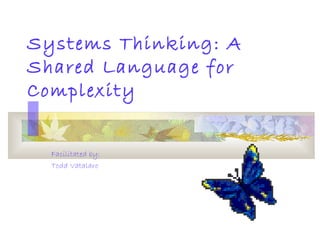Systems thinkinŌĆ”rpoint.7.02
- 1. Systems Thinking: A Shared Language for Complexity Facilitated by: Todd Vatalaro
- 2. The Power of the Butterfly
- 3. History
- 4. Objectives At the end of this presentation, you will be able to: ’ü« Define Systems Thinking ’ü« Use Systems Thinking in your own business model
- 5. What is Systems Thinking? A problem solving language used to allow people to understand their social system and improve it
- 6. Why is it different than fundamental problem solving? ŌĆ£Traditional analysis separates the individual pieces of what is being studiedŌĆØ ŌĆ£System thinking focuses on how the thing being studied interacts with the other constituents of the systemŌĆØ Aronson, Daniel, (1998) Overview of Systems Thinking. Retrieved July 4, 2002 fro the World Wide Web: www.thinking.net
- 7. What does Systems Thinking do? Systems thinking looks at the entire picture of the issue and all its interactive parts. It studies how parts interrelate
- 8. Glass of water illustration
- 9. What is the advantage? ’ü« Helps to solve complex issues ’ü« Identifies issues with dependence on past or actions of others ’ü« Creates a model to visualize ineffective (or effective) coordination of the actions of the environment
- 10. Case Scenario: Insects eating a crop Pesticide Application Insects Damaging Crops O O = Change in opposite direction S = Change in same direction
- 11. How is System Thinking Used? ’ü« Through casual loop diagrams or ŌĆ£archetypes) ’ü« Through a feedback process to look at patterns of behavior and events
- 12. Tell a story over time Insects damaging Crops Insects A damagin g crops Pesticide Applicati on Insect B increase s Insect B damag e TIme
- 13. Graph with a Loop
- 14. Systems Thinking Is ’ü« A language to help solve complex issues ’ü« Looks at the entire picture and its interactions ’ü« Uses casual loop diagrams to look at patterns of behavior and events
- 15. Evaluation???















